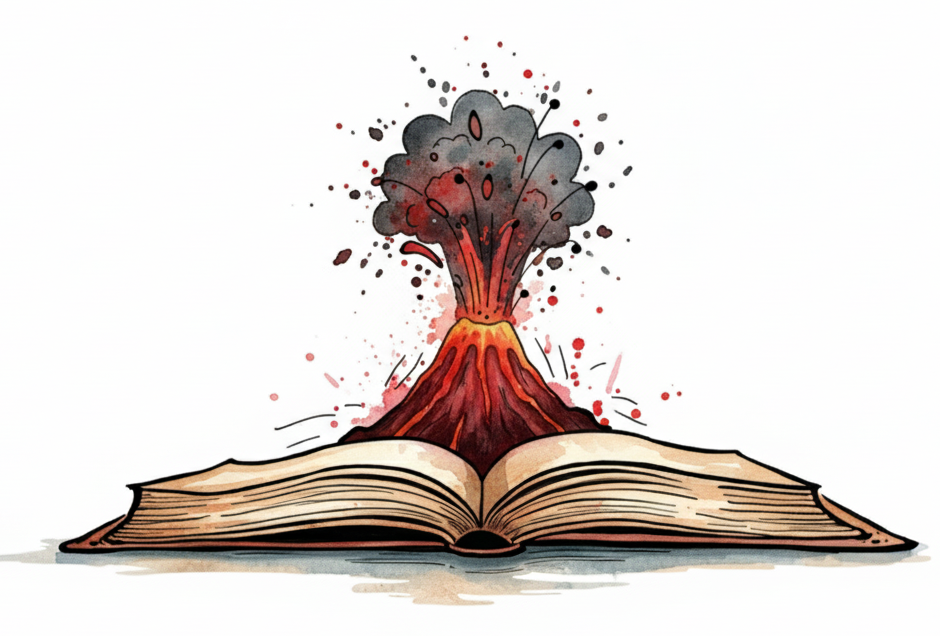A list of 8 Novels about Volcanoes

-
Pompeii by
In this historical thriller, Robert Harris places the reader in the final days of Pompeii through the eyes of a pragmatic engineer. The protagonist, Marcus Attilius Primus, is an aquarius—a water man—tasked with maintaining the massive aqueduct that supplies the region.
When the water flow mysteriously fails and sulfurous fumes foul the springs, Attilius uses his scientific mind, not superstition, to deduce that a catastrophic force is building within Mount Vesuvius.
Harris masterfully builds suspense by chronicling the technical and geological signs of the impending eruption, creating a tense, procedural-style narrative where the looming disaster is a problem to be solved against an impossible clock.
-
Under the Volcano by
Set during a single Day of the Dead in 1938, Malcolm Lowry’s modernist masterpiece uses its volcanic setting as a powerful, brooding metaphor for internal collapse. The narrative follows Geoffrey Firmin, a self-destructive British consul drinking himself to death in the shadow of the twin volcanoes Popocatépetl and Iztaccíhuatl.
While the volcanoes themselves are dormant, their immense and constant presence looms over the characters, symbolizing the sublime, destructive passions and inescapable doom that Firmin courts. The landscape is not merely a backdrop but a reflection of his psychological state, making the novel a searing portrait of a personal eruption.
-
The Last Days of Pompeii by
A quintessential 19th-century historical romance, this classic novel portrays Pompeii as a city of high drama, love, and moral conflict on the eve of its destruction. Unlike the technical focus of modern retellings, Bulwer-Lytton’s novel is rich with melodrama, featuring noble heroes, scheming villains, and a beautiful blind flower-seller.
Vesuvius functions as an instrument of divine judgment, a spectacular and terrifying force that brings an end to the city’s decadence and tests the character of its inhabitants. The narrative blends historical detail with high-stakes adventure, culminating in a harrowing escape as the volcano erupts.
-
The Volcano Lover by
Susan Sontag’s brilliant historical novel explores the intersections of art, science, and passion through the real-life figure of Sir William Hamilton, the British envoy to Naples and a fervent volcanologist.
Hamilton, known as "the volcano lover," channels his obsessive energy into collecting Roman antiquities and studying the every move of Mount Vesuvius.
Sontag draws a powerful parallel between the sublime, unpredictable violence of the volcano and the consuming passions of the human heart, particularly within the famous love triangle involving Hamilton, his wife Emma, and Admiral Lord Nelson. The volcano becomes a complex symbol of creation, destruction, and the intense drive to possess beauty.
-
Volcano by
In this contemplative novel, Shusaku Endo uses a dormant volcano in Japan as a profound metaphor for the hidden spiritual and moral struggles of his characters. The story centers on two men: Jinai, a disgraced Catholic priest, and Suda, a cynical volcanologist who has dedicated his life to studying the seemingly inactive mountain.
Both men are drawn to the volcano, seeing in it a reflection of their own inner turmoil—one of faith and doubt, the other of professional futility and mortality.
Endo masterfully explores the unspoken tensions and dormant anxieties that lie just beneath the surface of everyday life, suggesting they are as potent and unpredictable as the magma deep within the earth.
-
Journey to the Center of the Earth by
Jules Verne’s iconic adventure uses a volcano not as a threat, but as a gateway to the fantastic. The story begins when the impetuous Professor Otto Lidenbrock deciphers a runic manuscript that reveals a passage to the Earth’s core through the crater of Iceland’s Snæfellsjökull volcano.
For Verne, the volcano is a portal to wonder, embodying the 19th-century spirit of scientific discovery and the belief that nature’s greatest secrets are waiting to be unlocked.
The journey through the planet’s interior is filled with prehistoric marvels, and the novel fittingly concludes with the heroes being violently expelled back to the surface through an eruption from Stromboli, another active volcano.
-
Galápagos by
Narrated by a ghost from one million years in the future, this satirical novel chronicles the de-evolution of humankind after a small group of tourists and misfits are shipwrecked on the volcanic Galápagos Islands. The islands, famous for inspiring Darwin’s theory of evolution, become the crucible for a new human race.
In Vonnegut’s dark and humorous vision, the apocalyptic events that isolate the survivors are less important than the indifferent, shaping power of the natural environment itself.
The volcanic landscape is the stark and unforgiving laboratory where nature, through "the big brain" of natural selection, corrects humanity’s course, leading to a new species better adapted to survival.
-
Hawaii by
In this sweeping, multi-generational epic, James Michener begins his story before humans ever set foot on the islands. The first characters are the volcanoes themselves, rising from the sea floor in violent eruptions to create the landmass of Hawaii.
This geological birth story establishes the novel’s central theme: the land as a powerful force that shapes the destiny of all who inhabit it.
From the first Polynesian settlers to the American missionaries and Asian laborers, each wave of humanity must contend with the islands' volcanic legacy, which serves as a constant symbol of both creation and destruction, foundation and peril. The narrative weaves the raw power of geology directly into the fabric of human history.